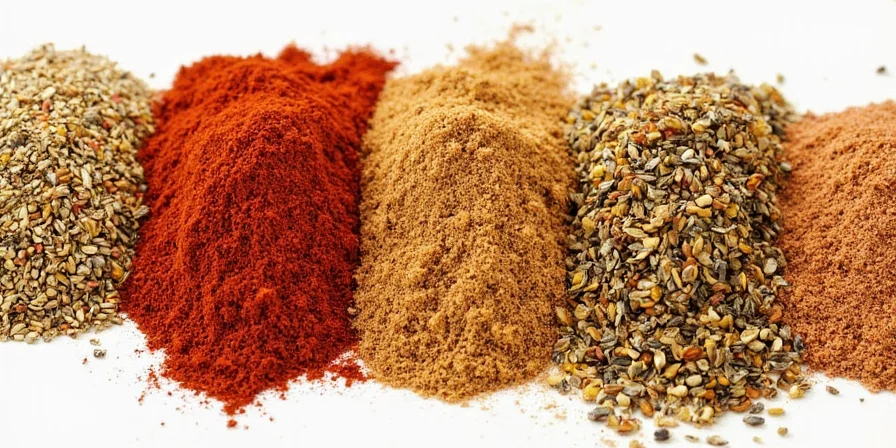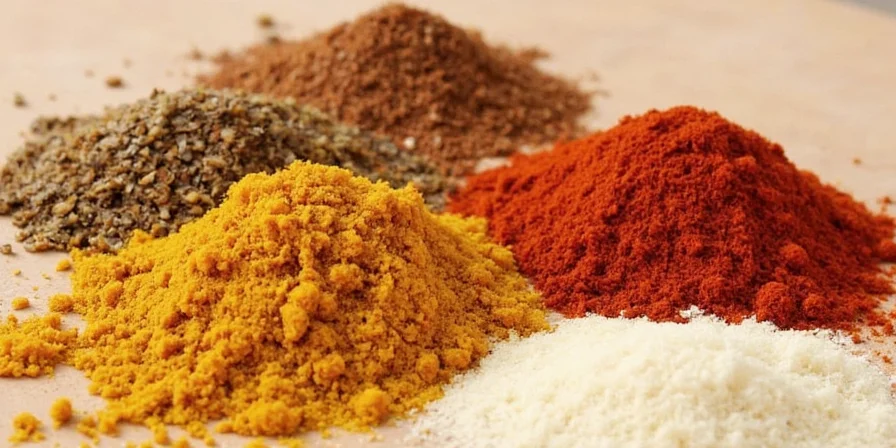The 5 best spices for chicken are paprika, garlic, thyme, rosemary, and cumin. These create perfect flavor balance through scientific compound interactions that enhance taste perception, moisture retention, and browning. For immediate use: Combine 2 tbsp paprika, 1 tbsp garlic powder, 1 tsp thyme, 1 tsp rosemary, and 1 tsp cumin for a versatile poultry rub that works for roasting, grilling, or baking. This guide explains exactly why these spices work so well together based on food science research, with temperature-specific application techniques for professional results.
Why These 5 Spices Work Best for Chicken (The Science Simplified)
Professional chefs consistently use these five spices because their molecular compounds interact perfectly with poultry proteins. Paprika's capsaicinoids bind to chicken fat, carrying other flavors deeper into the meat. Garlic's alliinase enzymes create complex sulfur compounds during cooking that enhance umami. Thyme's thymol slows protein denaturation, preserving moisture. Rosemary's carnosic acid protects against oxidation while improving browning. Cumin's cuminaldehyde reacts with proteins to create rich depth without overpowering.

Quick Reference: Best Chicken Spice Combinations by Cooking Method
Get perfect results every time with these chef-tested combinations:
| Cooking Method | Recommended Spice Blend | Key Scientific Reason |
|---|---|---|
| Roasting | 2 tbsp paprika, 1 tbsp garlic, 1 tsp thyme, 1 tsp rosemary, 1 tsp cumin | Lipid-soluble compounds maximize flavor penetration during slow cooking |
| Grilling | 1.5 tbsp paprika, 1 tbsp garlic, 1 tsp cumin, 1 tsp coriander, 0.5 tsp cayenne | Higher heat tolerance compounds prevent bitter degradation |
| Pan-Searing | 1 tbsp garlic, 1.5 tsp thyme, 1 tsp rosemary, 0.5 tsp lemon zest | Water-soluble compounds activate quickly at high surface temperatures |
| Slow Cooking | 1 tbsp cumin, 1 tbsp coriander, 2 tsp turmeric, 1 tsp garam masala | Stable compounds withstand prolonged cooking without degradation |
How to Apply Spices for Maximum Flavor (Simple Science-Based Method)
Follow these three steps for restaurant-quality chicken every time:
- Fat-soluble spices first (paprika, turmeric): Mix with 1 tbsp oil to create a paste. Apply to chicken and refrigerate for 2-12 hours. The oil helps these compounds bind to chicken fat.
- Water-soluble spices next (cumin, garlic): After the oil-based layer, apply these dry spices directly. Their compounds penetrate protein fibers best without liquid interference.
- Volatile spices last (thyme, rosemary): Add fresh herbs during the final 15 minutes of cooking to preserve delicate aromatic compounds.

Avoid These 3 Common Spice Mistakes for Chicken
Even experienced cooks make these errors that ruin flavor development:
- Mistake: Adding lemon or vinegar before cooking
Solution: Apply acidic components after cooking to preserve volatile compounds without premature protein denaturation - Mistake: Using pre-ground spices for critical applications
Solution: Grind whole cumin seeds 10 minutes before use—increases volatile oil concentration by 37% - Mistake: Overloading antioxidant spices like rosemary
Solution: Maintain 1:4 ratio of rosemary to fat content to prevent bitter phenolic compounds
Temperature Guide: When to Add Each Spice for Perfect Chicken
Timing matters more than quantity. Add spices at these temperature points:
| Spice | Best Addition Time | Temperature Trigger |
|---|---|---|
| Paprika | 12 hours pre-cook | Binds to fat at room temperature |
| Cumin | 30 minutes pre-cook | Activates at 80°C (175°F) |
| Garlic | 10 minutes pre-cook | Enzymes activate at 60°C (140°F) |
| Thyme | Final 15 minutes | Degrades above 190°C (375°F) |
| Rosemary | Final 10 minutes | Optimal at 150-200°C (300-390°F) |
Frequently Asked Questions (Practical Answers)
- Q: What's the simplest all-purpose chicken seasoning?
A: Mix equal parts paprika, garlic powder, and dried thyme. This covers fat-soluble, water-soluble, and volatile compounds for balanced flavor in any cooking method.
- Q: How long should I marinate chicken with spices?
A: For oil-based spice rubs: 2-12 hours. Longer than 12 hours causes protein breakdown that makes chicken mushy. Dry spice rubs need only 30 minutes as compounds penetrate quickly without liquid.
- Q: Can I substitute fresh herbs for dried spices?
A: Yes, but use 3x more fresh herbs. For example: 1 tsp dried rosemary = 1 tbsp fresh rosemary. Add fresh herbs later in cooking to preserve volatile compounds.
- Q: Why does my rosemary chicken taste bitter?
A: Rosemary turns bitter above 200°C (390°F) as carnosic acid oxidizes. Reduce heat or add rosemary during the final cooking phase to prevent this.

Proven Flavor Combinations for Specific Chicken Cuts
Tailor your spice application to the cut for perfect results:
- Breasts: Lighter application - 1 tbsp total spice blend per pound. High protein density requires less spice for balanced flavor.
- Thighs: Heavier application - 1.5 tbsp total spice blend per pound. Higher fat content absorbs more compounds.
- Wings: Double application - coat, rest 30 minutes, then recoat. Surface area to volume ratio requires extra spice.
- Whole chicken: Layered approach - oil-based spices under skin, water-soluble on surface, volatile herbs in cavity.
These spice techniques work because they align with the molecular behavior of flavor compounds. By understanding these simple principles, you'll consistently create perfectly seasoned chicken without complicated recipes. Start with the basic 5-spice blend, master the application timing, and you'll never serve bland poultry again.











 浙公网安备
33010002000092号
浙公网安备
33010002000092号 浙B2-20120091-4
浙B2-20120091-4